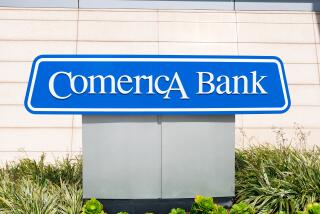Nation’s Banks Doing Better, Regulators Say : Even Farm Banks Found Recovering From Slump
- Share via
WASHINGTON — The nation’s commercial banks appear to be recovering from their worst year since the Depression despite mounting bank failures in the Southwest and continuing problems with loans to Third World countries, federal regulators said Wednesday.
“The banking system as a whole is sound and getting sounder. . . . The outlook for the immediate future is cautiously optimistic,” Federal Deposit Insurance Corp. Chairman L. William Seidman told the Senate Banking Committee.
The performance of farm banks, the sore spot of the industry several years ago, is slowly improving as agriculture recovers from its slump, he said.
The nation’s largest banks, bedeviled by shaky loans to less developed countries, wrote off big losses last year and now have “adequate, if not comfortable, reserves,” he said.
And there are signs that the economy of the Southwest, heavily dependent on the oil industry, has hit bottom and turned up.
Still, he warned, bank failures in Texas could rise from 50 last year to 70 this year because banks’ performance generally lags behind economic changes.
“We believe 1989 looks better (in Texas) for two reasons: Every major bank will have its problems resolved in one way or another. . . . And smaller banks are already showing some recovery in the first quarter” of 1988, he said.
Overseas Loans Blamed
Last year, by almost any measure, was the worst for the nation’s 13,650 commercial banks since 1933. A record 184 banks failed--Seidman expects about the same number this year--and banking as a whole posted its lowest profit level in 54 years, a 2.02% return on equity.
But, the entire drop can be attributed to the $20.6 billion in writeoffs for overseas loans, a move the regulators said has strengthened banks’ ability to deal with the problem.
“There are two areas of concern,” said the comptroller of the currency, Robert L. Clarke, whose office regulates nationally chartered banks. “But they should not overshadow the fact that the national banking system remains sound.”
Sen. William Proxmire (D-Wis.) agreed that “the picture this year is by no means gloomy,” but he raised concerns about the possibility that developing country loans will have to be written down still further.
Banks have written off the loans by about 25% to 30%, but they trade on the open market at only about 50 cents on the dollar, he said.
Federal Reserve Board Governor H. Robert Heller said “meaningful progress” has been achieved on the Third World debt problem. Because much of the value of the loans depends on the countries’ willingness, rather than their ability, to pay, judgments vary as to how much they should be written down.
Proxmire, chairman of the committee, also questioned the ability of banks to withstand a severe recession.
Could Handle Recession
“What haunts me is that Texas today might be the United States tomorrow if we have a national recession,” he said.
Seidman, whose agency insures bank deposits up to $100,000, said many banks are prepared to withstand a short recession with few ill effects.
He added, “The FDIC fund is adequate to deal with any problems we can foresee in the banking system in 1988.”
Compared to the fund that insures savings institutions, FDIC is in good shape, ending 1987 with $18.3 billion, up slightly from the end of 1986. But, the fund could record its first loss, depending on how much it costs to restore First Republicbank Corp. of Dallas to health.
At least one thrift industry trade group, the National Council of Savings Institutions, is eyeing FDIC as a potential source of money to rescue the savings and loan insurance fund, which most analysts say will not have enough money to meet the $20-billion to $60-billion price tag of cleaning up insolvent savings institutions.
Seidman vigorously opposed that idea, arguing that the money should come from the thrift industry and as a last resort, the taxpayer.
More to Read
Sign up for Essential California
The most important California stories and recommendations in your inbox every morning.
You may occasionally receive promotional content from the Los Angeles Times.













